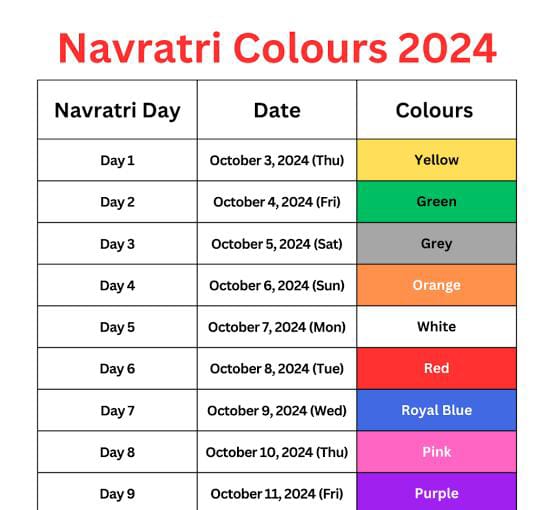Navratri is one of the most widely celebrated Hindu festivals, dedicated to the worship of Goddess Durga and her nine divine forms. In 2024, Shardiya Navratri will commence on Thursday, October 3. It signifies the victory of good over evil and is marked by nine days of fasting, prayer, and festive celebrations. One of the key aspects of Navratri is the tradition of wearing specific colours on each day, symbolising various attributes and energies of the Goddess.
Let’s explore the significance of the nine colours of Navratri, their associated meanings, and how they can enhance your festive spirit.
Navratri Day 1: Yellow Yellow is a warm and cheerful colour that represents optimism and happiness. Wearing yellow on the first day of Navratri invokes a sense of joy and positivity, setting the tone for the rest of the celebrations. It is believed that this vibrant colour keeps one enthusiastic throughout the day and brings in new energy.
Navratri Day 2: Green Green is the colour of nature, symbolising growth, fertility, and serenity. Wearing green on the second day of Navratri helps in maintaining inner peace and calmness. It is also associated with new beginnings and the hope of prosperity in one’s life.
Navratri Day 3: Grey Grey is a balanced and neutral colour that helps one stay grounded and maintain a sense of calmness. It signifies maturity and wisdom. Wearing grey on the third day of Navratri is ideal for those looking to participate in the festivities with subtle elegance and sophistication.
Navratri Day 4: Orange Orange is a vibrant and energetic colour that symbolises enthusiasm and warmth. It brings a sense of exuberance and positivity, making it the perfect colour to wear while worshipping Goddess Durga on the fourth day of Navratri.
Navratri Day 5: White White is synonymous with purity and peace. Wearing white on the fifth day of Navratri is believed to invite the divine blessings of the Goddess and foster a feeling of inner tranquillity and security. This day is dedicated to experiencing spiritual growth and calmness.
Navratri Day 6: Red Red is the colour of passion, love, and vigour. It is also the most preferred colour of the ‘Chunri’ offered to the Goddess during Navratri. Wearing red on the sixth day signifies strength and courage, filling the devotee with vibrant energy and determination.
Navratri Day 7: Royal Blue Royal Blue symbolises richness, elegance, and tranquillity. Wearing this vivid shade on the seventh day of Navratri brings a sense of sophistication and grace, allowing one to celebrate the festivities with unmatched style and charm.
Navratri Day 8: Pink Pink is associated with love, affection, and harmony. Wearing pink on the eighth day of Navratri invokes a sense of universal love and adds charm to the personality. It is believed that this colour strengthens relationships and brings happiness.
Navratri Day 9: Purple Purple represents luxury, grandeur, and nobility. It is a colour that symbolises opulence and spiritual awakening. Wearing purple on the last day of Navratri helps one connect with the divine energies and receive the blessings of Goddess Durga for a prosperous and successful life.
Significance of Wearing Navratri Colours
Wearing specific colours on each day of Navratri is not just a fashion statement but also a way to align oneself with the energies of the Goddess. Each colour holds unique significance and impacts the devotee’s mood, emotions, and thoughts. This tradition is particularly popular in states like Gujarat and Maharashtra, where women dress up in the colour of the day and celebrate the festival with enthusiasm.
Daily newspapers often publish the list of Navratri colours just before the festival, making it easier for devotees to follow this vibrant custom. Adorning the colours of Navratri not only adds to the festive mood but also allows devotees to express their devotion and reverence for Goddess Durga.
By incorporating these colours into your life during Navratri 2024, you can invite positivity, prosperity, and the divine blessings of the Goddess. Whether attending Garba and Dandiya events or offering prayers at home, wearing the Navratri colours of the day enhances the overall festive experience.



